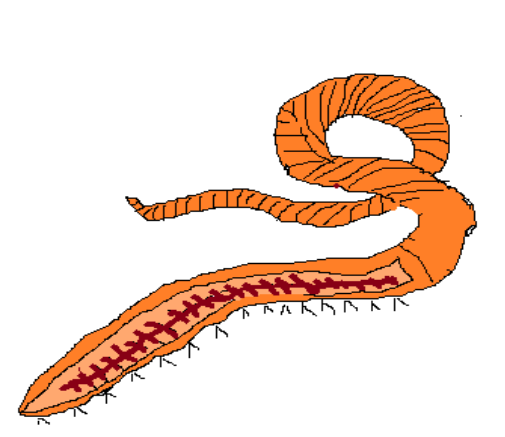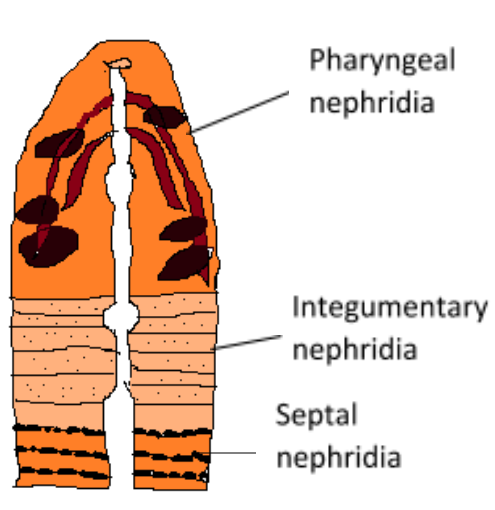
In which of the following organisms, its excretory organs are correctly stated
A) Cockroach-Malpighian tubules and enteric caeca
B) Earthworm-Pharyngeal, integumentary and septal nephridia
C) Frog-kidneys, skin, and buccal epithelium
D) Humans- kidneys, sebaceous glands and tear glands
Answer
495.9k+ views
1 likes
Hint: They belong to the category of annelids which have more evolved excretory organs. They are the terrestrial invertebrates that are externally segmented and contain setae on all the segments.
Complete Answer:
- The excretory organs of earthworm occur as segmentally arranged coiled like tubes which are called nephridia. There are three types of nephridia which includes septal nephridia, integumentary nephridia and pharyngeal nephridia.
- Two nephridia are present on each of the earthworm segments. Excretion occurs in earthworms through a pore which is called nephridiopore. These nephridia filter the dead cells and other types of waste that are stuck in blood. Wastes from the worms excreted through the same opening as the digestive waste.
Thus, the correct answer is option is B i.e., Earthworm-Pharyngeal, integumentary and septal nephridia.


Additional information:
- In cockroaches, Malpighian tubules are the part of excretory organs but enteric caeca plays a role in the digestion of food. On the other hand, excretory organs of frogs include kidney, pair of ureters, urinary bladder and cloaca.
- Skin is used in the absorption whereas buccal epithelium is used in the elimination of carbonic acid. In humans, excretory organs consist of sweat glands, liver, lungs, kidney. Sebaceous glands found in the skin of humans. Tear glands found in the eyes.
Note: Earthworms are the terrestrial invertebrates that have evolved excretory organs. Earthworm has three types of nephridia which helps in filtering the dead cells and waste from the worms. Nephridia are coiled like tubules.
Complete Answer:
- The excretory organs of earthworm occur as segmentally arranged coiled like tubes which are called nephridia. There are three types of nephridia which includes septal nephridia, integumentary nephridia and pharyngeal nephridia.
- Two nephridia are present on each of the earthworm segments. Excretion occurs in earthworms through a pore which is called nephridiopore. These nephridia filter the dead cells and other types of waste that are stuck in blood. Wastes from the worms excreted through the same opening as the digestive waste.
Thus, the correct answer is option is B i.e., Earthworm-Pharyngeal, integumentary and septal nephridia.


Additional information:
- In cockroaches, Malpighian tubules are the part of excretory organs but enteric caeca plays a role in the digestion of food. On the other hand, excretory organs of frogs include kidney, pair of ureters, urinary bladder and cloaca.
- Skin is used in the absorption whereas buccal epithelium is used in the elimination of carbonic acid. In humans, excretory organs consist of sweat glands, liver, lungs, kidney. Sebaceous glands found in the skin of humans. Tear glands found in the eyes.
Note: Earthworms are the terrestrial invertebrates that have evolved excretory organs. Earthworm has three types of nephridia which helps in filtering the dead cells and waste from the worms. Nephridia are coiled like tubules.
Latest Vedantu courses for you
Grade 9 | CBSE | SCHOOL | English
Vedantu 9 CBSE Pro Course - (2025-26)
School Full course for CBSE students
₹35,000 per year
Recently Updated Pages
Master Class 11 Economics: Engaging Questions & Answers for Success

Master Class 11 Business Studies: Engaging Questions & Answers for Success

Master Class 11 Accountancy: Engaging Questions & Answers for Success

Master Class 11 English: Engaging Questions & Answers for Success

Master Class 11 Computer Science: Engaging Questions & Answers for Success

Master Class 11 Maths: Engaging Questions & Answers for Success

Trending doubts
State and prove Bernoullis theorem class 11 physics CBSE

What are Quantum numbers Explain the quantum number class 11 chemistry CBSE

Write the differences between monocot plants and dicot class 11 biology CBSE

Why is steel more elastic than rubber class 11 physics CBSE

Explain why a There is no atmosphere on the moon b class 11 physics CBSE

1 ton equals to A 100 kg B 1000 kg C 10 kg D 10000 class 11 physics CBSE




